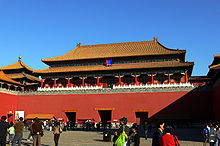- Meridian Gate
-
The Meridian Gate (simplified Chinese: 午门; traditional Chinese: 午門; pinyin: Wǔmén; Manchu: Julergi dulimbai duka) is the southern (and largest) gate of the Forbidden City. It has five arches. The three central arches are close together; the two flanking arches are farther apart from the three central arches. The center arch was formerly reserved for the Emperor alone; the exceptions were the Empress, who could enter it once on the day of her wedding, and the top three scholars of the triennial civil service examinations, who left the exams through the central arch. All other officials and servants had to use the four side arches.
Above the arches are a series of buildings. The central one is the palace of nine bays wide, with double roofs. In each side, the 13 bays-wide building, single roof, connects the two pavilions on the top. The Emperor of China reviewed his troops from this location during the Ming and Qing dynasties.
Its superstructure is also called the "Five Phoenix Turrets" because it is composed of five buildings.[1] Imperial proclamations and almanacs were issued from the gate house. After successful campaigns, the Emperor received prisoners of war here, sometimes followed by mass decapitations.[2]
Although urban myth has it that senior officers were executed here in Imperial China; in reality only corporal punishment was actually carried out.
Behind the viewer is Duanmen Gate, the principal entrance to the imperial palace grounds.
When proceeding northward through the palace grounds, the next major gate encountered is the Gate of Supreme Harmony.
In popular culture
In the Nickelodeon animated television show Avatar: The Last Airbender, in the Earth Kingdom capital city of Ba Sing Se, the main gate to the Imperial Palace is based on the Meridian, almost identical in appearance.
References
Old city of Beijing Subdivisions 
Fortifications and towers Yongdingmen Gate • Zhengyangmen Gate • Zhonghuamen • Tiananmen Gate • Deshengmen Gate • Bell and Drum towersForbidden City Temples and gardens Beihai Park • Shichahai • Zhongnanhai • Jingshan Park • Zhongshan Park • Fragrant Hills • Temple of Heaven • Temple of Earth • Temple of the Sun • Temple of the Moon • Confucius Temple • Taimiao (Imperial Ancestral Temple) • Xiannongtan (Temple of Agriculture) • Yonghe Temple • Fayuan Temple • White Cloud Temple • Zhen Jue Temple • Miaoying Temple • Wanshou Temple • Temple of Azure Clouds • Badachu • Dongyue Temple • Guanghua Temple • Tanzhe Temple • Wofo Temple • Big Bell Temple • Bailin Temple • Guangji Temple • Fahai Temple • Changchun Temple • Zhihua Temple • Yunju TempleCoordinates: 39°54′45″N 116°23′28″E / 39.9125°N 116.39111°E
Categories:- Forbidden City
- Chinese architectural history
Wikimedia Foundation. 2010.



